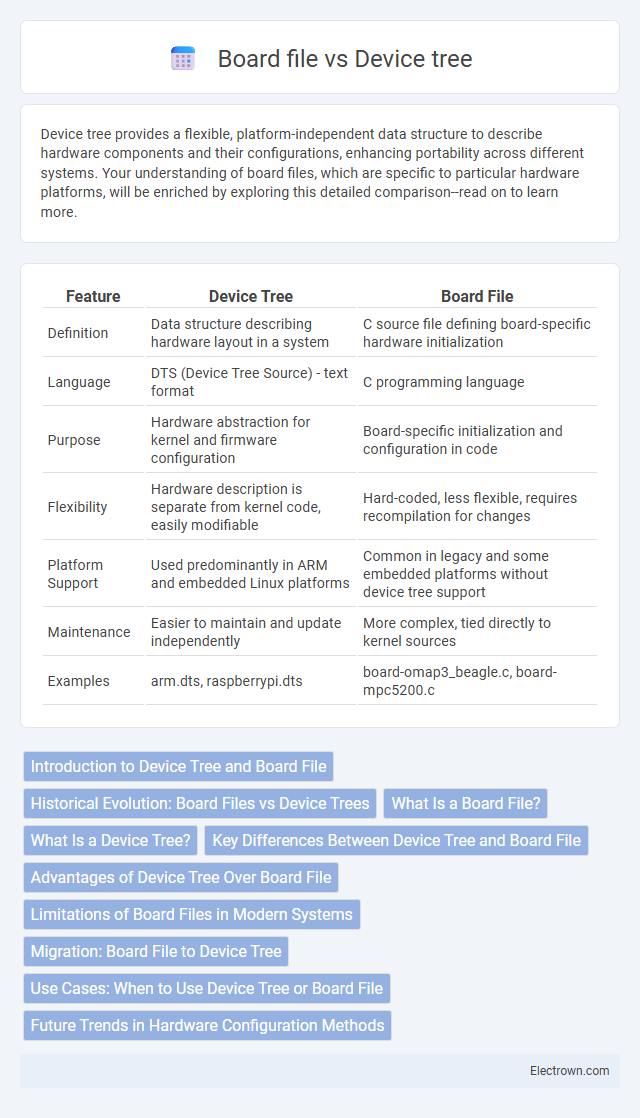Device tree provides a flexible, platform-independent data structure to describe hardware components and their configurations, enhancing portability across different systems. Your understanding of board files, which are specific to particular hardware platforms, will be enriched by exploring this detailed comparison--read on to learn more.
Table of Comparison
| Feature | Device Tree | Board File |
|---|---|---|
| Definition | Data structure describing hardware layout in a system | C source file defining board-specific hardware initialization |
| Language | DTS (Device Tree Source) - text format | C programming language |
| Purpose | Hardware abstraction for kernel and firmware configuration | Board-specific initialization and configuration in code |
| Flexibility | Hardware description is separate from kernel code, easily modifiable | Hard-coded, less flexible, requires recompilation for changes |
| Platform Support | Used predominantly in ARM and embedded Linux platforms | Common in legacy and some embedded platforms without device tree support |
| Maintenance | Easier to maintain and update independently | More complex, tied directly to kernel sources |
| Examples | arm.dts, raspberrypi.dts | board-omap3_beagle.c, board-mpc5200.c |
Introduction to Device Tree and Board File
Device Tree is a data structure used to describe hardware components and their configurations in a system, enabling the operating system to manage devices without hardcoded settings. Board files are platform-specific source code files containing initialization routines and hardware information tailored for a particular board, often used in kernel development. Your understanding of Device Tree allows for flexible hardware description, while board files provide the necessary low-level setup for device functionality.
Historical Evolution: Board Files vs Device Trees
Board files were traditionally used in early embedded Linux systems to describe hardware by hardcoding device addresses and configurations directly in C source files, leading to limited flexibility and increased maintenance. The introduction of device trees brought a more modular and scalable approach by using a plain-text hardware description language, which enables easier hardware abstraction and supports diverse platforms without recompiling the kernel. Device trees have become the standard in modern Linux kernels, replacing board files to improve portability, reduce code duplication, and streamline hardware support across multiple architectures.
What Is a Board File?
A board file is a hardware-specific configuration source in embedded Linux that provides essential details about the board's components, such as CPU, memory, and peripherals, enabling kernel customization for that particular hardware. Unlike device trees, which use a data structure to describe hardware in a platform-independent manner, board files are typically written in C and include initialization code directly tied to the board's architecture. Board files dictate platform setup during kernel compilation, influencing low-level hardware initialization and driver bindings.
What Is a Device Tree?
A Device Tree is a data structure for describing hardware components in a system, enabling the operating system to understand the hardware layout without hardcoding specifics in the kernel. It provides a standardized way to represent devices, buses, and peripherals, allowing for greater flexibility and portability across different hardware platforms. Your Linux kernel relies on the Device Tree to configure and initialize devices during boot, minimizing the need for custom board files.
Key Differences Between Device Tree and Board File
Device tree and board files both define hardware configurations for embedded systems but differ fundamentally in structure and usage. Device trees use a hierarchical data structure to describe hardware components and their relationships in a platform-independent manner, enabling easier maintenance and portability. Board files, specific to the Linux kernel, contain platform-specific initialization code and configurations written in C, tightly coupling hardware details with the kernel source.
Advantages of Device Tree Over Board File
Device Tree offers enhanced maintainability by separating hardware description from the board-specific initialization code, allowing for easier updates and scalability across multiple platforms. It enables dynamic hardware configuration without modifying kernel source, promoting portability and reducing compilation times. Furthermore, Device Tree supports better hardware abstraction, simplifying support for diverse devices within a single kernel.
Limitations of Board Files in Modern Systems
Board files face significant limitations in modern systems due to their inflexible and hardware-specific nature, making maintenance and scalability difficult as hardware evolves. Device trees offer a more dynamic and modular approach, allowing device configuration to be abstracted from board code, improving portability across different platforms. The reliance on static board files impedes support for complex hardware topologies and dynamic device management, which are essential in contemporary embedded and SoC environments.
Migration: Board File to Device Tree
Migrating from board files to device trees involves converting static board-specific configurations into a flexible, hardware-description format enabling easier hardware abstraction and scalability. Device trees separate hardware description from the operating system kernel, allowing your system to support new hardware without recompiling low-level board files. This transition improves maintainability and supports diverse hardware platforms with unified configuration management.
Use Cases: When to Use Device Tree or Board File
Use device trees primarily for hardware description in systems with complex or diverse peripherals, enabling easier OS-level configuration and scalability, especially in Linux-based embedded platforms. Board files remain useful for simpler or legacy systems where hardware details are tightly coupled with initialization code, providing direct control over platform-specific setup. Your choice depends on the need for portability and maintainability, with device trees favored in modular designs and board files suited for fixed hardware configurations.
Future Trends in Hardware Configuration Methods
Future trends in hardware configuration methods emphasize the increasing adoption of Device Trees over traditional board files due to their enhanced modularity and maintainability. Device Trees enable dynamic hardware description that simplifies kernel support for diverse platforms, fostering faster development cycles and improved compatibility. Emerging frameworks may further integrate Device Trees with machine learning algorithms for automated configuration optimization in complex hardware environments.
Device tree vs board file Infographic

 electrown.com
electrown.com